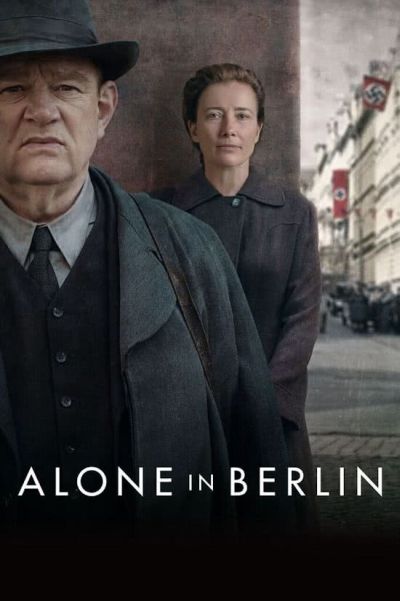| Title: | Alone in Berlin |
| Director: | Vincent Perez |
| Cast: | Emma Thomson, Brendan Gleeson, Daniël Brühl, a.o. |
| Released: | 2016 |
| Playing time: | 103 minutes |
| Description: |
A tablet like hundreds of others which can be found on buildings in the German capital, is fixed on the wall of Amsterdamerstraße 10. The porcelain tablet shows the names of Otto and Elise Hampel who lived here from 1943 to 1943. Their resistance against the contempt of people by the Nazi regime was the inspiration for the novel "Jeder stirbt für sich allein" (everybody dies for himself) by Hans Falada is written on it. The book, published world wide, was made into a movie entitled "Alone in Berlin" by Swiss director Vincent Perez in 2016. German author Hans Falada, who made his debut in 1920, wrote his book about the Hampels after the war in hardly four weeks while admitted to a psychiatric clinic because of a depression. Shortly after, in February 1947, he died at the age of 53 from heart problems caused by a years of addiction to morphine, alcohol and other drugs. His novel, based on the Gestapo files on the Hampels was released that same year in the Soviet occupation zone in Germany. Various translations soon followed like in Russian and in Dutch but an English version appeared as late as 2009. In the first German printing, aspects unpleasant to the Communists had been omitted, like the fact the Hampels had initially sympathized with the Nazis. In the novel as well as in the movie, Quangel instead of Hampel is the family name of the workers couple. While the death of Elise Hampel’s brother at the front was the real occasion that encouraged the couple to their resistance, in Falada’s story and in the movie, it is the death of their only son. In the movie, we see the father, grieving for his son, who starts writing texts in protest against the regime on picture postcards he subsequently leaves behind in the entrance of apartment buildings. "Mother, Hitler murdered my son" is the first message with which he wants to encourage his fellow citizens to revolt against the Nazi regime. The foreman in a carpentry equates his resistance with dropping sand in a machine. A few grains of sand make no impact but he hopes that his message will encourage others to resist. He is convinced that many grains of sand will eventually ground the Nazi war machine to a halt. In any case, Otto Hampel is assisted by his wife who helps him distributing the picture postcards all over Berlin although she is a valued member of the NS-Frauenschaft, the Nazi women’s movement. They drop over 200 cards in various locations in the city. The tragedy of their act of resistance is that most of the cards are handed over to the authorities by citizens who are afraid or angry. The regime wants to put a stop to the covert distribution of these undermining messages. Gestapo inspector Escherich is charged with tracking down the culprit(s). He baptizes his search Operation Ghost and sticks red markers on his map of the city where the cards have been found. As the map grows increasingly red, the policeman feels the hot breath down his neck of the SS leadership which wants to capture the culprit at all costs and does not shy away from using unusual methods in achieving its goal. Apart from the workers couple, other tenants of their apartment building are also portrayed, including an elderly Jewish lady whose husband has disappeared, a respectable judge, a youngster who is a member of the Hitler Jugend and a sneaky petty thief. It is a cross-section of German society at the time of the Nazi regime where good and bad appeared in all sorts of forms. Nobody escaped the grip of the Nazis on society, made possible by the deployment of party members and snitches checking or spying on everyone. The fact that two common civilians without any links to organized resistance rose against the authorities in this controlling state requires courage and a moral attitude few people possess. Marching in step and bringing the Hitler salute – and sometimes taking advantage of someone else’s misery – was a lot easier. The peculiarity of the resistance of the Hampel/Quangel couple, as modest it may have been, is convincingly shown in the movie. Alone in Berlin is certainly no spectacular resistance movie. It is a modest portrait of a kind of resistance which may be nerve wracking for the executor but in reality is much less spectacular than other kinds of resistance. There were no secret meetings or smuggling trips, no shootings or bombings. Picture postcards, a fountain pen and a pair of gloves (to avoid leaving fingerprints on the paper) were the only tools and a man and his wife the sole executors. Although it will take a little getting used to the actors speaking English instead of German, the acting is smart, in particular by Emma Thompson and Brendan Gleeson playing the Quangels. Without uproar, grand décors and surprising story lines, the makers have managed to produce a captivating movie which is a fine tribute to the Hampel couple and all those others who rise above the crowds in dark times and use the pen as a weapon against injustice. |
| Rating: |     (Very good)
(Very good) |
Information
- Translated by:
- Arnold Palthe
- Article by:
- Kevin Prenger
- Published on:
- 30-11-2017
- Last edit on:
- 09-06-2018
Images


